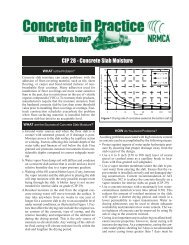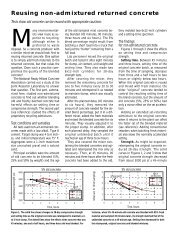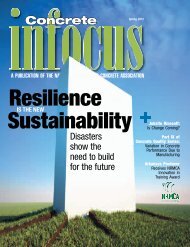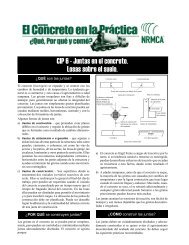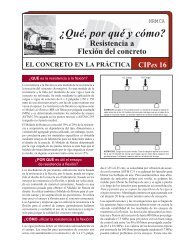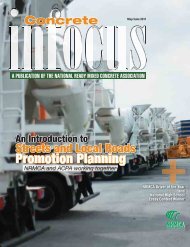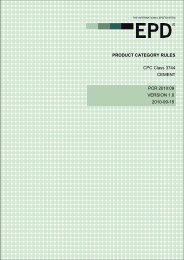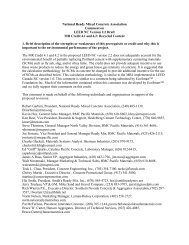2010 NRMCA - National Ready Mixed Concrete Association
2010 NRMCA - National Ready Mixed Concrete Association
2010 NRMCA - National Ready Mixed Concrete Association
Create successful ePaper yourself
Turn your PDF publications into a flip-book with our unique Google optimized e-Paper software.
emoved the entrapped fi nes from the top1/8 in. of a ¼ inch-deep void.Other Photomicrographs fromAfter MaintenanceThe photomicrographs in Figure 8 wereadditional photos taken of pervious concretefollowing maintenance by the 8 in. vacuumhose, regenerative air sweeper, or vacuumsweeper. The photos reinforce that theentrapped fi nes were mostly concentrated inthe top ¼ in. of the pervious concrete and,regardless of the maintenance performed,only the top 1/16-1/8 in. of entrapped fi neswere removed.FIGURE 8. Photomicrographs of pervious concretefollowing maintenance by 8 in. vacuum hose, regenerativeair sweeper, or vacuum sweeper.Coarse Sand FinesWhile small fi nes and organic matterremained within the top ¼ in. of theinterconnected void spaces and tended toconsolidate into tightly packed masses, thelarger fi nes such as coarse sand particleswere observed in interconnected voidsthroughout the depth of the cores. Figure9 shows an example of coarse sand particlesthat migrated 3 in. into a pervious concretepavement.FIGURE 9. Pervious concrete exposed to sand during thewinter and spring snow melt. Sand particles migratedthree inches into the pervious concrete voids.CONCLUSIONThree possible methods of pervious concretepavement maintenance were attempted,and all were equally effective at removing thetop 1/8” of fine and organic material from thepervious concrete pavements. The fine andorganic materials that were responsible forthe partial or total impermeability of the perviousconcretes typically consolidated within¼ in. of the concrete’s surface. Pervious concretevoids deeper than ¼ in. were rarely fi lledby these materials. If fines were found in theinterconnected void areas beneath ¼ in.,these fines were typically larger sand particlesand did not appear to impede permeability ofthe pervious concrete.Entrapped fines were not entirely removedduring maintenance. Instead, the total thicknessof consolidated fines within a void spacewas decreased and the remaining fines weredisturbed enough so that the pervious concretewas able to infiltrate water according todesign. The rate at which the voids were fi lledwith fine and organic matter depended on theexposure of the pervious concrete to fine andorganic material, which varied by site.ACKNOWLEDGEMENTSThis research was completed with a grantfrom the <strong>Ready</strong> <strong>Mixed</strong> <strong>Concrete</strong> (RMC)Research & Education Foundation.Mark Maloney, Tom Wesolowski andMike Shaughnessy, City of Shoreview PublicWorks Department.Andjela Tomovic, City of Saint CloudDepartment ofEngineering.For more information contact:Mary VancuraGraduate Research AssistantUniversity of MinnesotaDepartment of Civil Engineering500 Pillsbury Drive S.E.Minneapolis, MN 55455Phone: 612-597-3431E-mail: vanc0060@umn.eduKevin MacDonaldVice President of Engineering ServicesCemstone Products Co.2025 Centre Pointe Blvd #300Mendota Heights, MN 55120Phone: 612-363-7111E-mail: kmacdonald@cemstone.comLev KhazanovichAssociate ProfessorUniversity of MinnesotaDepartment of Civil Engineering500 Pillsbury Drive S.E.Minneapolis, MN 55455Phone: 612-624-4764E-mail: khaza001@umn.edu■The research taking place at the University of Minnesota was funded bythe RMC Research & Education Foundation. The Foundation supportsresearch and educational programs that will increase professionalismand quality in the concrete industry. Additional information about theFoundation’s work may be found at www.rmc-foundation.org.Additional pervious concrete resources available from theRMC Research & Education Foundation include:■ Pervious <strong>Concrete</strong> Research Compilation■ Construction & Maintenance Assessment of Pervious <strong>Concrete</strong>■ Hydraulic Performance Assessment of Pervious <strong>Concrete</strong> Pavements forStormwater Management Credit■ Portland Cement Pervious Pavement: Field Performance Investigationon Parking Lot and Roadway PavementsAll of the reports noted above are included on the Foundation’sResearch Supporting Sustainable Development deliverables CD.Other pervious concrete research projects currently underwayinclude:■ Heat Island Mitigation Through Use of Pervious <strong>Concrete</strong>■ Pervious <strong>Concrete</strong> Mix Design for Wearing Course Applications36 ı JANUARY/FEBRUARY 2011



